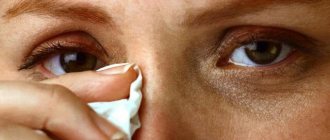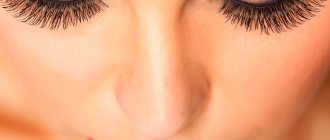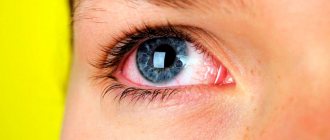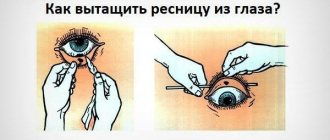Content:
Description
↑ SYNONYMS
Chemical, thermal, radiation damage to the eyes.
↑ ICD-10 CODE
T26.0
. Thermal burn of the eyelid and periorbital region.
T26.1
. Thermal burn of the cornea and conjunctival sac.
T26.2.
Thermal burn leading to rupture and destruction of the eyeball.
T26.3.
Thermal burn of other parts of the eye and its adnexa.
T26.4
. Thermal burn of the eye and its adnexa of unspecified localization.
T26.5
. Chemical burn of the eyelid and periorbital area.
T26.6.
Chemical burn of the cornea and conjunctival sac.
T26.7.
Chemical burn leading to rupture and destruction of the eyeball.
T26.8.
Chemical burn to other parts of the eye and its adnexa.
T26.9.
Chemical burn of the eye and its adnexa of unspecified localization.
T90.4.
Consequence of eye injury in the periorbital region.
↑ CLASSIFICATION
- I degree
- hyperemia of various parts of the conjunctiva and limbus, superficial erosions of the cornea, as well as hyperemia of the skin of the eyelids and their swelling, slight swelling.
II degree
b - ischemia and superficial necrosis of the conjunctiva with the formation of easily removable whitish scabs, clouding of the cornea due to damage to the epithelium and superficial layers of the stroma, the formation of blisters on the skin of the eyelids.
III degree
- necrosis of the conjunctiva and cornea to the deep layers, but not more than half the surface area of the eyeball. The color of the cornea is “matte” or “porcelain”. Changes in ophthalmotonus are noted in the form of a short-term increase in IOP or hypotension. Possible development of toxic cataracts and iridocyclitis.
- IV degree
- deep damage, necrosis of all layers of the eyelids (up to charring). Damage and necrosis of the conjunctiva and sclera with vascular ischemia on the surface of more than half of the eyeball. The cornea is “porcelain”, a tissue defect of more than 1/3 of the surface area is possible, in some cases a perforation is possible. Secondary glaucoma and severe vascular disorders - anterior and posterior uveitis.
↑ ETIOLOGY
Conventionally, chemical (Fig. 37-18-21), thermal (Fig. 37-22), thermochemical and radiation burns are distinguished.
↑ CLINICAL PICTURE
Common signs of eye burns:
the progressive nature of the burn process after the cessation of exposure to the damaging agent (due to metabolic disorders in the tissues of the eye, the formation of toxic products and the occurrence of an immunological conflict due to autointoxication and autosensitization to the post-burn period);
tendency to relapse of the inflammatory process in the choroid at various times after receiving a burn;
Stages of the burn process:
- Stage I (up to 2 days) - rapid development of necrobiosis of affected tissues, excess hydration, swelling of the connective tissue elements of the cornea, dissociation of protein-polysaccharide complexes, redistribution of acidic polysaccharides;
Stage II (days 2-18) - manifestation of pronounced trophic disorders due to fibrinoid swelling:Stage III (up to 2-3 months) - trophic disorders and vascularization of the cornea due to tissue hypoxia;
- Stage IV (from several months to several years) is a period of scarring, an increase in the amount of collagen proteins due to increased synthesis by corneal cells.
↑ DIAGNOSTICS
The diagnosis is made based on the history and clinical picture.
↑ TREATMENT
Basic principles of treating eye burns:
- provision of emergency care aimed at reducing the damaging effect of the burn agent on tissue;
When providing emergency care to a victim, it is necessary to intensively rinse the conjunctival cavity with water for 10-15 minutes, with obligatory eversion of the eyelids and rinsing of the lacrimal ducts, and careful removal of foreign particles.
Surgical interventions on the eyelids and eyeball in the early stages are carried out only for the purpose of preserving the organ. Vitrectomy of burned tissues, early primary (in the first hours and days) or delayed (after 2-3 weeks) blepharoplasty with a free skin flap or a skin flap on a vascular pedicle with a simultaneous transplantation of automucous tissue to the inner surface of the eyelids, fornix and sclera are performed.
Planned surgical interventions on the eyelids and eyeball for the consequences of thermal burns are recommended to be carried out 12-24 months after the burn injury, since against the background of autosensitization of the body, allosensitization to the graft tissue occurs.
For severe burns, it is necessary to inject 1500-3000 IU of antitetanus serum subcutaneously.
↑ Treatment of stage I eye burns
Long-term irrigation of the conjunctival cavity (for 15-30 minutes).
Chemical neutralizers are used in the first hours after a burn. Subsequent use of these drugs is inappropriate and can have a damaging effect on the burned tissue. The following means are used for chemical neutralization:
- alkali - 2% boric acid solution, or 5% citric acid solution, or 0.1% lactic acid solution, or 0.01% acetic acid:
For severe symptoms of intoxication, Belvidon 200-400 ml is prescribed intravenously once a day, 200-400 ml at night (up to 8 days after injury), or a 5% dextrose solution with ascorbic acid 2.0 g in a volume of 200-400 ml, or 4- 10% dextran solution [cf. they say weight 30,000-40,000], 400 ml intravenously.
NSAIDs
: diclofenac (orally 50 mg 2-3 times a day before meals, course 7-10 days) or indomethacin (orally 25 mg 2-3 times a day after meals, course 10-14 days).
H1 receptor blockers
: chloropyramine (25 mg orally 3 times a day after meals for 7-10 days), or loratadine (orally 10 mg once a day after meals for 7-10 days), or fexofenadine (orally 120-180 mg 1 time per day after meals for 7-10 days).
Kinds
Thermal burns according to ICD-10 (International Classification of Diseases, 10th revision) have a range code from T20 to T-32. Each type has its own ICD 10 code, which is then indicated in the diagnosis in the medical history.
T20 – T25 Thermal and chemical burns of the external parts of the body, with a specific localization. The list indicates the stage of damage. Thermal burns according to ICD-10:
- T20. Heads and necks.
- T21. Mid body.
- T22. The upper free limb, excluding the wrist and phalanges of the fingers.
- T23. Wrists and hands.
- T24. The lower limb, except the ankle and plantar part of the foot.
- T25. Ankle and foot areas.
- T26. Limited to the periorbital zone.
- T27. Upper respiratory tract.
- T28. The entire area of the eyeball.
- T29. Several areas of the body.
- T30. Uncertain localization.
Classifiers with codes from T30 to T32 are compiled depending on the affected surface of the adult body. The burn code determines the class of disease.
Eye burn
All iLive content is reviewed by medical experts to ensure it is as accurate and factual as possible.
We have strict sourcing guidelines and only link to reputable sites, academic research institutions and, where possible, proven medical studies. Please note that the numbers in parentheses ([1], [2], etc.) are clickable links to such studies.
If you believe that any of our content is inaccurate, out of date, or otherwise questionable, please select it and press Ctrl + Enter.
Causes of eye burns
Eye damage most often occurs as a result of contact with chemicals, thermal agents, various radiations, and electric current.
- Alkalis (slaked or quicklime, lime mortar) upon contact with the eyes lead to the most serious burns, causing necrosis and destroying the tissue structure. The conjunctiva takes on a greenish tint, and the cornea becomes porcelain white.
- Acids. Acid burns are not as serious as alkaline burns. The acid causes the corneal protein to clot, which prevents damage to the deeper structures of the eye.
- Ultraviolet radiation. An ultraviolet eye burn can occur after tanning in a solarium, or if you look at bright sunlight reflected from the surface of water or snow.
- Hot gases and liquids. The stage of the burn depends on the temperature and duration of exposure.
- A special feature of an electric shock burn is painlessness and a clear distinction between healthy and dead tissue. Severe burns provoke eye hemorrhages and retinal swelling. Clouding of the cornea also occurs. When exposed to electric current, both eyes are often affected.
[6], [7], [8], [9]
Eye burn from welding
When the welding machine operates, an electric arc is generated that emits ultraviolet radiation. This radiation can cause electroophthalmia (severe burn of the mucous membrane). The reasons for the occurrence are non-compliance with safety regulations, powerful ultraviolet and infrared radiation, and the effect of smoke generated during welding on the eyes. Symptoms: indomitable lacrimation, acute pain, eye hyperemia, swollen eyelids, pain when moving the eyeballs, photophobia. If electroophthalmia occurs, it is forbidden to rub your eyes with your hands, since rubbing only intensifies the pain and leads to the spread of inflammation. It is important to immediately wash the eyes. If the retina is not damaged by the burn, then vision will be restored within one to three days.
[10], [11], [12], [13]
First aid for burns
First aid for burns is carried out depending on what substance caused destructive lesions in the eye.
Radiation burns
With prolonged exposure of the eye to infrared and ultraviolet rays, a burn of the cornea develops. The problem is manifested by photophobia and excessive lacrimation. The problem with diagnosis is that the patient's symptoms appear only after 8-10 hours.
First aid is to suppress pain. To do this, anesthetic drops are instilled into the eyes themselves, and a cotton pad soaked in anesthetic drops is placed on the eyelid of the damaged eye. It is advisable to wear dark glasses at all times.
Chemical burns
Chemical burns are considered when alkalis and acids come into contact with the surface of the eye. An alkaline burn is considered the most dangerous; it is severe, affects the deep layers of the eyeball, and often provokes loss of vision. Symptoms include severe redness and erosion on the surface of the eye, vision problems, foreign body sensation, and significant defects on the surface of the eye.
First aid is aimed at quickly removing a dangerous chemical from the eye; for this, the eye must be actively rinsed under running water for 15 minutes, then anesthetic drops are instilled into the eye. You can wipe your eye with a solution of rich black tea (the liquid should not be hot).
It is important to seek medical help immediately.
Thermal burns
Thermal burns develop in cases when boiling water gets on the cornea, boiling fat or oil splashes, an open flame is exposed, for example, in a fire, or molten hot metal gets in contact (during professional activities without protection).
The problem manifests itself as severe pain in the eye area, muscle spasms, swelling of the skin, and blurred vision. Thermal burns often affect not only the cornea of the eye, but also the surrounding skin. First aid is provided according to the principle:
Remnants of the substance that caused the burn are removed from the eye
This can be done either with a cotton pad or by rinsing with clean running water; Drops are placed into the eye for pain relief; An ointment containing antibiotics is placed in the eye; It is important that the ointment is prescribed exclusively by the attending physician.
Glue burn during eyelash extensions
Quite nonspecific burns occur in beauty salons when applying eyelash extensions. Due to the technician's mistakes, the glue gets on the cornea, resulting in a chemical burn. The main symptoms of this type of burn include:
- The appearance of severe itching in the eyeball area;
- Redness of the mucous membranes;
- Sensation of a foreign body, severe pain when moving the eye.
It is important to promptly rinse the eye with clean running water. You can also use a slightly pink solution of potassium permanganate
Potassium permanganate neutralizes harmful chemicals in the glue.
Pepper spray burn
If for any reason you get pepper spray in your eye, you may experience involuntary closure of the affected eye and an inability to open your eyes due to severe pain.
To reduce the negative impact, you need to rinse your eyes with clean running water for 15 minutes. The greatest effectiveness will come from washing the eyes with water using a shower, with the stream directed directly into the eye.
Remember that even if first medical aid was provided in a timely manner, after a burn, regardless of its type, scars may still remain on the surface of the eye. They are invisible to the naked eye, but the problem significantly impairs visual acuity.
Burns to the cornea of the eye are a rather dangerous phenomenon, which, if not diagnosed and treated in a timely manner, can result in complete loss of vision. The cornea is a rather sensitive part of the eye, which is easily affected by negative effects.
It is important to provide eye protection in any way, especially when working with hazardous chemicals, as well as walking in the open sun.
If you suspect a burn has developed, you should immediately seek medical help. If it is not possible to visit a doctor, the patient must be given first aid.
Risk factors
The most common burns to the cornea are in construction, manufacturing, and agriculture, but they also occur at home.
Alkalies are especially dangerous because they penetrate the corneal tissue faster and easier. This leads to the death of superficial tissues, and the deep layers of the eye are often damaged. As a result, intraocular pressure may increase and cataracts develop.
Acids cause denaturation of the protein of the surface layers of the cornea, limiting penetration into the tissue, but can nevertheless lead to blindness. The exception is hydrofluoric acid, which quickly penetrates cell membranes and causes necrosis. In addition, fluoride ions that penetrate into the cell reduce the activity of glycolytic enzymes, and also bind to calcium and magnesium to form insoluble compounds.
The next group of substances that can cause a corneal burn consists of irritants that have a neutral pH, and although their exposure causes similar symptoms, their exposure does not cause irreparable damage.
In everyday life, burns to the cornea of the eye occur due to the ingestion of ammonium hydroxide, ammonium sulfite, potassium hydroxide, magnesium oxide and calcium hydroxide compounds. They are found in plant fertilizers and cleaning products (ammonia). Often in everyday life you can find: hydrochloric acid, sulfuric acid, nitric acid and acetic acid. Sulfuric acid can be released when a vehicle's radiator ruptures and catches fire. We use acetic acid to prepare preserves. Eye remover and nail polish are very damaging to the eyes.
Irritants are also used in household cleaners, repellents and sprays. All of the chemicals listed above can cause eye burns.
You need to be especially careful with various electrical appliances. Make sure that there is no damage to the housing or wire and that it is working properly. A burn is also possible when observing a phenomenon such as a solar eclipse, if you are exposed to the rays of the bright sun for a long time without tinted glasses. Ultraviolet light that enters the eyes can damage the retina, leading to vision impairment. This can cause swelling and redness of the eyes, keratoconjunctivitis. Sometimes, clouding of the cornea occurs. When going on vacation to the sea or to the mountains, you need to protect your eyes from the bright sun.
[14], [15], [16], [17], [18], [19], [20]
Signs of a burn
The photo shows a chemical burn of the eye due to exposure to a chemical drug.
The organ of vision can be damaged:
- open fire;
- boiling water and steam;
- chemical effects on the eyeball (lime, acid and alkali);
- less often it is affected by ultraviolet and infrared radiation;
- Ionizing damage to the organs of vision occurs under the influence of radiation sources.
Symptoms of a burn include the following:
Signs and symptoms of eye burns in the photo
- A mild degree is manifested by sharp pain, redness and slight swelling of the surrounding tissue. There is a feeling of a foreign body, a violation of the contrast of vision of objects, and blurred vision.
- Under the influence of high temperature on the organs of vision, the conjunctiva dies. As a result, ulcers form, which lead to the fusion of the eyelid with the eyeball.
- When the cornea, the front convex part of the eye, is damaged, lacrimation and photophobia occur, vision is impaired from simple deterioration to complete loss.
- When the iris of the eye is damaged, which regulates the dilation and contraction of the pupil and clouding of the retina, the organ of vision becomes inflamed and vision decreases. Infection of the resulting wounds leads to damage, and deep chemical burns cause perforation and death of the eye.
Initial assistance is carried out at the scene of the accident - it consists of rinsing the eye and applying medications. More intensive treatment is provided in a medical facility.
Stages
Burns come in four stages. The first is the easiest, respectively, the fourth is the heaviest.
- The first degree is redness of the eyelids and conjunctiva, clouding of the cornea.
- Second degree - blisters and superficial films on the conjunctiva form on the skin of the eyelids.
- The third degree is necrotic changes in the skin of the eyelids, there are deep films on the conjunctiva that are practically not removed and the clouded cornea resembles opaque glass.
- The fourth degree is necrosis of the skin, conjunctiva and sclera with deep opacification of the cornea. An ulcer forms in place of the necrotic areas, the healing process of which ends with scars.
Diagnosis of eye burns
As a rule, there are no problems with diagnosing an eye burn. It is established on the basis of characteristic symptoms and interviews with the patient or witnesses to the event. The diagnosis should be made as soon as possible. Using tests and examination: the doctor determines the factor that caused the burn and draws up a conclusion.
After the end of the acute period, in order to assess the damage, it is recommended to conduct instrumental and differential diagnostics - an external examination of the eye using an eyelid lifter, measure intraocular pressure, conduct biomicroscopy to identify ulcers on the cornea, and ophthalmoscopy.
[47], [48], [49], [50], [51]
Treatment of eye burns
Emergency care is aimed at determining what substance caused the burn. The irritant must be removed from the eye as soon as possible. It can be removed with a tissue or cotton swab. If possible, the material is removed from the conjunctiva by everting the upper eyelid and cleaning it with a swab. Then rinse the affected eye with water or a disinfectant solution, such as a two percent boric acid solution, a three percent tannin solution, or other liquids. Rinsing should be repeated for several minutes. To reduce the severe pain and fear that accompanies a burn, the patient can be anesthetized and given sedatives.
You can use a dicaine solution (0.25-0.5%) for drip anesthesia. The eye is then covered with a sterile bandage covering the entire eye, and the patient is then immediately transported to the hospital for further vision-saving steps. In the future, it is necessary to fight to prevent fusion of the eyelids and destruction of the cornea.
It is recommended to place a pad of gauze on the eyelids, which is soaked in antiseptic ointment, using drops of eserine 0.03%. It is allowed to use eye drops with antibiotics:
- tobrex 0.3% (instill 1-2 drops every hour; contraindications – intolerance to any component of the drug; can be prescribed to children from birth.),
- signicef 0.5% (1-2 drops every two hours up to eight times a day, reducing the dosage to four times a day. The duration of treatment is determined individually. Side effects are local allergic reactions.),
- drops of chloramphenicol 0.25% instilled with a pipette once three times a day, one drop)
- Taufon drops 4% (locally, in the form of instillation two or three drops 3-4 times a day. There are no contraindications or side effects),
- in severe conditions, dexamethasone is prescribed (can be prescribed both locally and by injection, 4–20 mg intramuscularly three to four times a day).
Do not allow the damaged eye to dry out. To prevent this from happening, apply generous lubrication with Vaseline and xeroform ointment. Anti-tetanus serum is administered. For general maintenance of the body in case of a corneal burn, it is recommended to prescribe vitamins during the rehabilitation period. They are used orally or as intramuscular or intravenous injections.
Massage and physiotherapeutic treatment can be used to improve blood circulation.
The goal of inpatient treatment is to preserve eye function as much as possible. For first and second degree burns, the prognosis is favorable. For the latter two, surgical treatment is indicated—layer-by-layer or penetrating keratoplasty.
After the acute phase of the burn has passed, you can use folk, homeopathic and herbal remedies.
Treatment of burns with traditional methods
It is necessary to eat as many carrots as possible, as they contain carotene, which is beneficial for our eyes.
Add fish oil to your diet. It contains nitrogenous material and polysaturated acids that promote tissue restoration.
For a minor burn from electric welding, you can cut a potato in half and apply it to your eyes.
Herbal treatment
One tablespoon of dried clover flowers is poured into one glass of boiling water and left for one hour. Use for external use.
Dry thyme (one spoon) is poured with one glass of boiling water. Let it brew for one hour. Apply externally.
Pour twenty grams of crushed plantain leaves into 1 cup of boiling water and leave for one hour. For external use.
Homeopathic remedies
- Oculoheel - the drug is used for eye irritation and conjunctivitis. Anti-inflammatory. Prescribed for adults: one or two drops twice a day. There are no contraindications. There are no known side effects.
- Mucosa compositum - used for inflammatory, erosive diseases of the mucous membranes. At the beginning of treatment, one ampoule is prescribed every day for three days. There are no known side effects. There are no contraindications.
- Gelseminum. Gelseminum. The active substance is made from the underground part of the Gelsemium evergreen plant. Recommended for relieving acute stabbing pain in the eye and glaucoma. Adults take 8 granules three to five times daily.
- Aurum. Aurum. A remedy for deep lesions of organs and tissues. Recommended intake for adults: 8 granules 3 times a day. It has no contraindications.
All traditional and non-traditional treatment methods given in this article are for informational purposes only. What may have a positive effect on one person may not work for another. Therefore, do not self-medicate, visit a specialist.
source
Chemical burn of the eyes - code according to ICD-10, traumatic flame erosion of the cornea and facial trauma
Chemical burns to the organs of vision occur due to contact with aggressive chemicals. They lead to damage to the anterior part of the eyeball, cause unpleasant symptoms: pain, irritation and can lead to vision problems.
Main features
An eye burn is not a disease, but a pathological condition that can be eliminated if you consult an ophthalmologist in time.
List of symptoms:
- Sharp pain in the eyes. But this information will help you understand why pain occurs in the eyeball when pressing.
- Redness of the conjunctiva.
- Discomfort, burning sensation, irritation.
- Increased tear production.
It is difficult not to notice chemical damage to the organ of vision. It's all about pronounced symptoms, which gradually increase.
Chemical substances act gradually. Once on the skin of the eyes, they cause irritation, but if the burn is left unattended, its manifestations will only intensify.
Aggressive reagents gradually damage the skin of the eyelids and eyes. The extent of the “injuries” inflicted and their severity can be assessed after 2–3 days. But what types of eyelid diseases there are in humans and what drops should be used are indicated in this article.
Classification of burns
- 1st degree . Damage to the soft tissues of the eyelid and sclera is minor. Deep parts of the organ of vision: the cornea and retina are not affected. But why the cornea becomes cloudy can be seen here.
- 2nd degree .
Damage to the soft tissues of the eyelid is significant. Redness of the conjunctiva is noted, the symptoms are pronounced. The anterior parts of the organ of vision are slightly damaged, which leads to scarring of the tissue. - 3rd degree .
In addition to local damage to the eye, severe redness is noted. The tissue of the eyelid is damaged, the conjunctiva is severely irritated, there is cyanosis of the tissue, clouding of the cornea, and its focal damage. But how to properly use eye ointment for inflammation for children can be seen here. - 4th degree there is damage to the cornea, retina and necrosis of corneal and conjunctival tissue.
The damage is so pronounced that there is severe or complete loss of vision.
The video shows a description of a chemical burn to the eye:
Clinical manifestations
- Damage to the surface of the skin of the eyelids.
- The presence of foreign substances in the tissues of the conjunctiva. But what the symptoms of eye conjunctivitis in children may be can be seen here.
- Increased intraocular pressure (ocular hypertension).
Extensive damage to the skin occurs upon contact with reagents.
The substances irritate the mucous membrane, which leads to redness and irritation of the anterior parts of the eyeball.
During an ophthalmological examination, particles of foreign substances are detected; they are clearly visible during a clinical examination. Carrying out research helps to determine which substance led to the development of damage (acid, alkali).
The reagents act on parts of the eyeball in a special way. Contact results in “desiccation” or drying out of the mucosal surface and an increase in intraocular pressure levels. But what are the symptoms of high eye pressure in adults is described in great detail in this article.
Assessing the totality of symptoms helps to make the correct diagnosis for the patient. An ophthalmologist determines the degree of burn, performs diagnostic procedures and selects adequate treatment.
ICD-10 code
- T26.5 – chemical burn and area around the eyelid;
- T26.6 – chemical burn with reagents with damage to the cornea and conjunctival sac;
- T26.
7– severe chemical burn with tissue damage leading to rupture of the eyeball;
- T26.8 – chemical burn affecting other parts of the eye;
- T26.
9- a chemical burn that affected the deep parts of the eyeball.
First aid
If the tissues of the eyeball, eyelids and conjunctiva are damaged, the patient needs first aid.
So, the principles of its provision:
- It is necessary to rinse the eyes thoroughly with saline solution. But what solution for contact lenses should be used first and what reviews there are, this information will help you understand.
- Instill local anesthetics into the organs of vision (to reduce the severity of pain).
- Take painkillers.
Do not wash your eyes with running water or use cosmetic creams. This may increase signs of chemical exposure.
Once on the skin, the cream creates a protective shell on top, as a result of which the effect of aggressive reagents is enhanced. For this reason, you should not apply creams or other cosmetics to the skin.
What medications can you use:
- potassium permanganate solution;
- Furacilin;
- saline solution.
The potassium permanganate solution should be weak, it will help neutralize the effect of aggressive substances. You can dilute potassium permanganate, prepare furatsilin, or simply rinse your vision with warm, slightly salted water.
You should wash your eyes as often as possible, every 20–30 minutes. If the symptoms are severe, then you can take painkillers: Ibuprofen, Analgin or any other painkillers.
Treatment
It is advisable to consult a doctor when the first signs of a chemical burn appear. The doctor will select adequate therapy and help reduce unaccepted symptoms.
Most often the following drugs are prescribed for treatment:
- Antiseptics (various solutions for hygiene procedures, washing). But what antibiotics should be used for barley on the eye of children and what they are called. indicated in this article.
- Antibiotics (antimicrobial drugs).
- Anti-inflammatory drugs (used only if there are signs of an inflammatory process).
- Local anesthetics (used if a person cannot tolerate pain).
- Preparations based on human tears (moisturize and soften the mucous membrane). But what kind of moisturizing drops there are when wearing contact lenses can be seen here.
Antiseptics are part of combination therapy; they stop the inflammatory process and promote the restoration of soft tissues, relieve swelling and redness.
Antibacterial drugs are prescribed to relieve the inflammatory process. They promote the death of pathogenic microflora and accelerate the process of cell regeneration.
Anti-inflammatory drugs also include glucocorticosteroids; they enhance the effect of antibacterial medications and antiseptics. With regular use, the intensity of unpleasant symptoms is reduced.
Local anesthetics are used in the form of drops. They help reduce the intensity of pain.
If there is an increase in the level of intraocular pressure (most often diagnosed upon contact with alkalis), then medications are used that reduce the signs of intraocular hypertension.
Medicines based on human tears. They help soften the irritated conjunctiva and reduce signs of the inflammatory process, remove swelling and partially hyperthermia of the eyelid.
List of drugs prescribed for eye burns:
| Group of drugs: | Name: |
| Glucocorticosteroids: | Prednisolone, Hydrocortisone in ointment form. |
| Antibiotics: | Tetracycline, Erythromycin ointment |
| Antiseptics: | Sodium chloride, Potassium permanganate. |
| Anesthetics: | Dicaine solution. |
| Preparations based on human tears: | Visoptic, Vizin. |
| Drugs that reduce the manifestations of intraocular hypertension: | Acetazolamide, Timolol. |
| Medicines that accelerate regenerative processes in cells: | Solcoseryl, Taurine. |
Solcoseryl is available in the form of an ointment; the drug significantly speeds up the healing process and helps to avoid pronounced scarring of the tissue.
And taurine as a substance “inhibits” the development of irreversible changes in the parts of the eyeball.
Instructions for use of Visoptic drops, like other medications, describe in detail the dosage and frequency of use. Carefully follow the rules for using any medications!
Timolol is the substance that ophthalmologists prefer when signs of high intraocular pressure appear.











